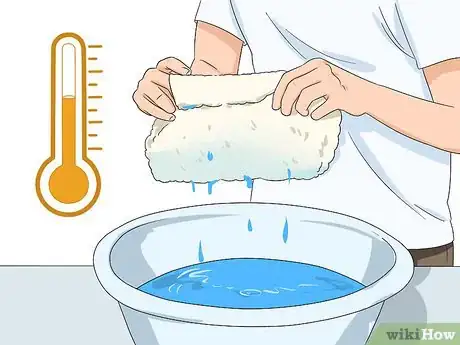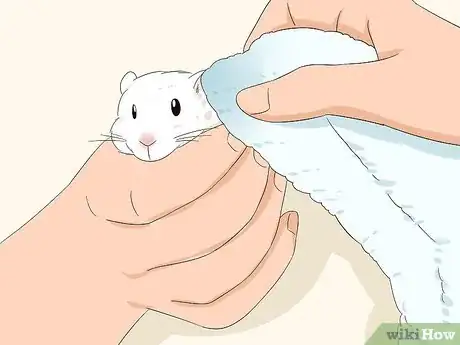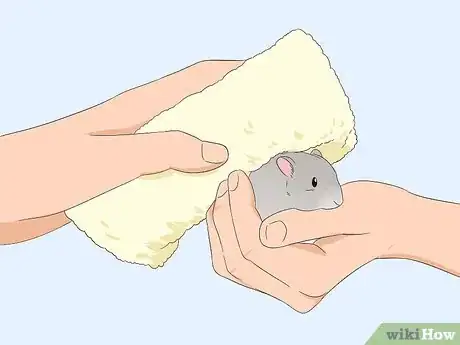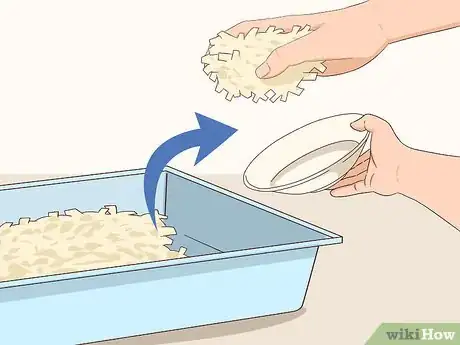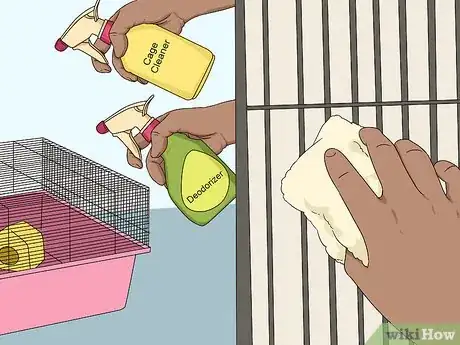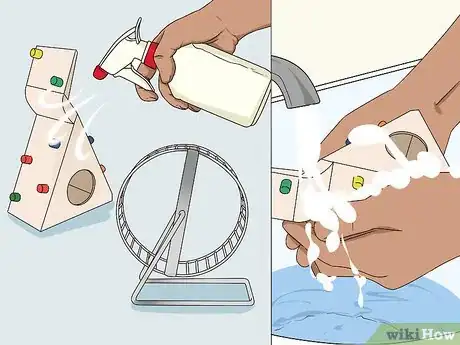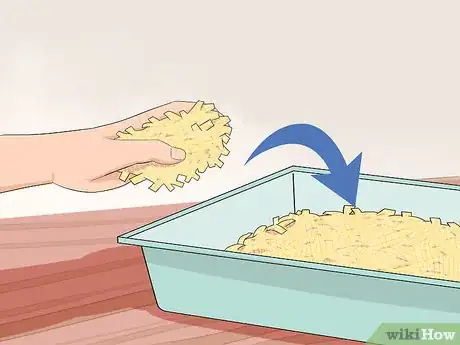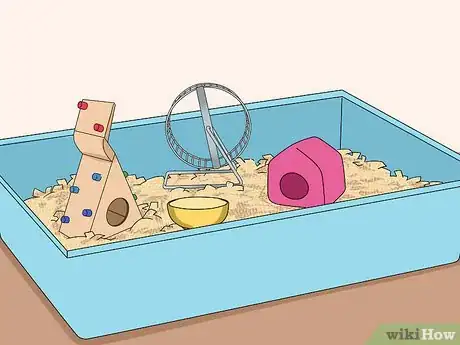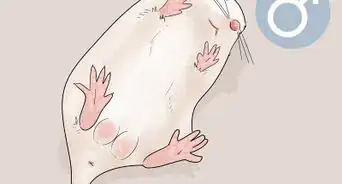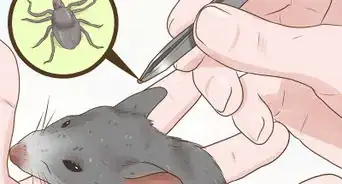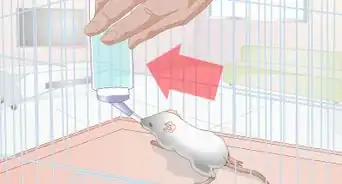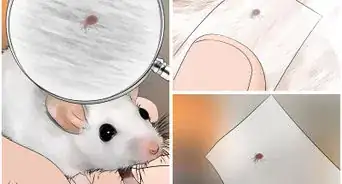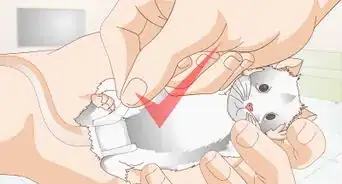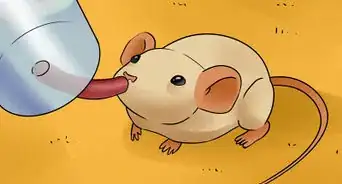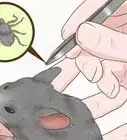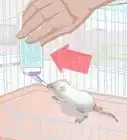X
This article was co-authored by Pippa Elliott, MRCVS. Dr. Elliott, BVMS, MRCVS is a veterinarian with over 30 years of experience in veterinary surgery and companion animal practice. She graduated from the University of Glasgow in 1987 with a degree in veterinary medicine and surgery. She has worked at the same animal clinic in her hometown for over 20 years.
This article has been viewed 14,316 times.
Mice are very clean pets. In fact, unless they're old or sick, they self-clean. However, mice can still get very stinky, which can result from a dirty living environment. If your mouse is smelly, you can wash it directly with washcloths and clean its cage and surroundings. You'll have a clean, non-smelly mouse in no time!
Steps
Method 1
Method 1 of 2:
Cleaning the Mouse with a Washcloth
-
1Dampen a washcloth with warm water. Submerge your washcloth in warm water. Make sure the water is temperate, not too hot or cold. Wring out any excess water, so that the washcloth is not dripping.[1]
- Mice do not like water, so make sure the washcloth is not too soaked! It should be damp.[2]
- Be careful to not make the water hot or cold, as either end can upset a mouse’s skin if directly applied.
- Choose the softest washcloth available to you.
-
2Rub the mouse with the damp washcloth. Rub the washcloth over and slightly under the mouse’s fur. Make sure to rub over the entirety of the mouse. Continue gently rubbing until the unpleasant smell is gone.[3]
- Do not forget to clean the feet! The feet can trap a lot of icky waste, which can contribute to the mouse’s smelliness.
- Be careful of the mouse’s eyes, nose, and ears. These are especially delicate areas.[4]
Advertisement -
3Rub the mouse with water and puppy shampoo for an even deeper clean. If water alone could not get rid of that pesky smell, you can use a gentle puppy shampoo to help.[5] Use a washcloth to softly rub over and under the mouse’s fur. Continue this action until the smell is gone.
- Do not apply puppy shampoo directly to the mouse. Add the shampoo to water, which you can then dip your washcloth into. Ring out any excess.[6]
- Use a tiny amount of puppy shampoo. You will not need more than a few drops.[7]
- If the smell is not going away, it is likely that your mouse has a health issue. Take it to a veterinarian to get examined.[8]
-
4Wash off the mouse with a damp washcloth. This needs to be done immediately after you finish shampooing the mouse. Take a wet washcloth and rub it on the mouse’s fur until the shampoo is gone.[9]
- Do not use hot or cold water. It should be warm.
- Ring out any excess water before applying the washcloth to the mouse.
-
5Rub the mouse with a dry washcloth. Rub and pat the mouse lightly. Make sure to dry all areas of the mouse. Continue this until the mouse is completely dry.[10]
- Use a soft washcloth, as a harsh one can hurt the mouse.
- Do not air-dry or blow-dry the mouse. Air-drying keeps the mouse wet for longer and blow-drying can hurt a mouse’s ears.[11]
Advertisement
Method 2
Method 2 of 2:
Cleaning the Mouse’s Surroundings
-
1Remove the mouse from its cage. The mouse should be out of the way while you are cleaning. Safely place it in an enclosed location, where it cannot run away.[12] Remember to periodically check on the mouse to make that it is comfortable and has not escaped.
-
2Remove bedding and litter from the mouse cage. Discard all bedding to make sure you remove all the mouse’s waste. Do this every week, as a buildup of mouse waste and old food is unsanitary, can lead to bacteria growth, and can make a mouse smelly.[13]
- For daily cleaning, you can just remove wet or soiled areas.[14]
-
3Disinfect and wash the mouse cage. Use a non-toxic cage cleaner and deodorizer to spray the entirety of the cage. Then, use a washcloth or paper towel to wipe up excess cleaner. Rinse thoroughly with water and dry well.[15]
-
4Disinfect and wash all toys and accessories. Just like the cage, spray all surfaces of the wheel, den, climbing wall, etc. Wipe the excess cleaner off with a washcloth or paper towel. To finish, rinse all items thoroughly with water and dry them completely.[18]
- If the manufacturer of the toys or accessories gives specific cleaning instructions, follow them.[19]
-
5Add clean bedding to the cage. You can use either recycled paper pellets or wood shavings. Take the bedding and completely cover the bottom of the cage. Continue filling until the layer of bedding is around one inch thick.[20]
- Do not use pine or cedar wood shavings. They can release fumes that can make your mouse ill.[21]
- You can add shredded paper towels or straw to the bedding. These are soft materials that can also be used by your mouse to make a comfy nest.
- Do not put newspaper in the mouse’s cage because the ink can rub off.[22]
-
6Put back all toys, accessories, and dishes. Now that everything is clean, place all your mouse’s items back. Try to put them in the same place they were in when you removed them. Do not forget to fill the water and food bowl before adding them back!
- Once you've done this, you can put your mouse back in its fresh, clean home!
Advertisement
Warnings
- Mice are quite small and sensitive. Water upsets them and getting shampoo in their eyes or ears can cause irritation. Be very careful when washing them.[24]⧼thumbs_response⧽
- Disinfectant if ingested by a mouse can be dangerous. Make sure to wash the cage and accessories thoroughly after disinfecting them.[25]⧼thumbs_response⧽
- While mice have a slight odor, they are self-cleaning. They are not naturally smelly. If they are producing an unpleasant scent that is not a result of dirty surroundings, they likely have a health issue. Take them to a veterinarian.[26]⧼thumbs_response⧽
Advertisement
References
- ↑ https://www.petbarn.com.au/petspot/small-animal/care-and-maintenance-small-animal/care-pet-mouse/
- ↑ https://animals.mom.me/bathe-mice-1703.html
- ↑ https://animals.mom.me/bathe-mice-1703.html
- ↑ https://animals.mom.me/bathe-mice-1703.html
- ↑ https://animals.mom.me/bathe-mice-1703.html
- ↑ https://animals.mom.me/bathe-mice-1703.html
- ↑ https://animals.mom.me/bathe-mice-1703.html
- ↑ https://animals.mom.me/bathe-mice-1703.html
- ↑ https://animals.mom.me/bathe-mice-1703.html
- ↑ https://animals.mom.me/bathe-mice-1703.html
- ↑ https://animals.mom.me/bathe-mice-1703.html
- ↑ https://www.drsfostersmith.com/pic/article.cfm?aid=1282
- ↑ http://animals.mom.me/control-odor-mouse-cage-1540.html
- ↑ http://animals.mom.me/control-odor-mouse-cage-1540.html
- ↑ https://www.petful.com/other-pets/getting-pet-mice/
- ↑ http://animals.mom.me/disinfect-hamster-cage-1484.html
- ↑ http://animals.mom.me/disinfect-hamster-cage-1484.html
- ↑ https://www.drsfostersmith.com/pic/article.cfm?aid=1282
- ↑ http://animals.mom.me/control-odor-mouse-cage-1540.html
- ↑ https://www.petful.com/other-pets/getting-pet-mice/
- ↑ https://www.petful.com/other-pets/getting-pet-mice/
- ↑ https://www.petful.com/other-pets/getting-pet-mice/
- ↑ https://www.drsfostersmith.com/pic/article.cfm?aid=1282
- ↑ https://www.petbarn.com.au/petspot/small-animal/care-and-maintenance-small-animal/care-pet-mouse/
- ↑ https://www.drsfostersmith.com/pic/article.cfm?aid=1282
- ↑ https://animals.mom.me/bathe-mice-1703.html
About This Article
Advertisement
